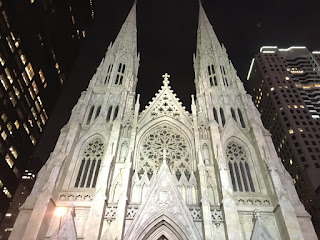Chris Cheung
American Religious Texts
Professor Steidl
April 27, 2016
Bushwick Collection
The artifact that I came across recently was
found while visiting the Bushwick area of Brooklyn located on the northern
border between Brooklyn and Queens. I came across this large mural, which stuck
out from the rest of the murals I came across while strolling the notorious
Bushwick Collective art collection that the area is famous for. By walking down
the streets of the Bushwick area, you will notice there is no shortage of
murals to admire. This particular mural was situated on the side of what
appeared to be a two-story high residential building. It might be difficult to judge
from the picture I took with my cell phone, but the intricacy and detail of the
mural was astounding. Even a mural that was standing at more than twenty feet
high had just as much detail as the murals at arms height. Probably requiring
many hours to complete, I was more than impressed by the level of craftsmanship
needed to create this mural.
From my perspective, the mural appeared to be
depicting the Virgin Mary, but instead of holding the baby Jesus, she is
clutching a white cutout of a baby. It is an interesting piece of artwork that
allows the viewer to reflect on what the artist is trying to say by just having
the outline of a baby instead. My own interpretation of what the mural is
trying to communicate is that the baby cutout represents all of us as unique
individuals. As a viewer, I think we are supposed to view ourselves as
individuals in place of the outline. By putting ourselves in that role, I am
interpreting that the Mary is watching over us and caring for us as a mother
would for her child. She is watching over and protecting all of us, as the role
of the mother is seen. Although that is my interpretation of what this mural
represents, I could be well off from what the artist is trying to communicate
as well.
One of the reasons I chose this particular
mural was because it reminded me of the Lady of Guadalupe, or the Nican
Mopohua, reading at the beginning the of the semester. When we discussed the
significance of the text during class, an important point was how the culture
depicted the Lady of Guadalupe giving her physical features and clothing of
their own people. With the Bushwick area being predominantly of Latino descent,
it is interesting to note that the Virgin Mary is depicted as the white
Anglican view that most people in the U.S. associate with as well. It is
interesting that the Virgin Mary did not translate over to other cultures as it
happened with the Nican Mopohua. It is interesting that despite the diversity
of cultures, religions, and nationalities, the Virgin Mary has a standardized
look and role in the Christian community. Although the story of the Nican
Mopohua is still celebrated in the origins of the city in Mexico, many people
from Mexico would be more familiar with the Anglican view of Mary. Thus, it makes
sense that despite the large concentration of the Latino community in the
Bushwick area, the Latino community is associated with the European view of Mary.
This mural also connected well to the three
aspects of our class, which are American, religious, and text. From the notion
of this artifact as being “American,” there are a few distinct characteristics
that I would point out. The biggest detail of the mural is the use of red,
white, and blue, which are the colors of the United States’ flag. Whether it
was intentional or not, the colors subliminally are familiar to people in the
United States because of the common patriotism of our national flag’s colors.
The use of these specific colors has an effect on the audience even if it is
subliminal. Another point of “Americanism” that I also pointed out earlier was
the message that we are special and unique from everyone else. If my
interpretation is correct, then the message is that Mary is specifically
watching over us and this goes right along the “American” idealism as well.
When looking at the mural from a “religious”
aspect, it is most likely the first thing that comes to mind. The religious
aspect of this mural was the reason I stopped to and thought it would relate to
our class discussions. When one looks at this mural, their first impression
most likely comes from a religious side more than anything else, which says
something about the intended audience. It can also be said that the intended
audience is of a Christian descent, given its specific biblical reference.
Finally, by looking at this mural as a “text,”
a few of the first details I notice are the physical size of the mural in that
it is very large, and also the use of the dark background to draw the
audiences’ eye. By using the dark black background against colorful and bright
colors, the mural allows the audience to be drawn in to the center of the
painting and away from the building’s edges. This use of color and size help
the audience to forget that you are looking at the side of a residential
building.
This mural was just one of many unique and interesting murals of the Bushwick area that I would highly recommend visiting. Many of these murals cannot only be related to our class discussions on American Religious Texts, but also are great for general enjoyment and curiosity as well.







